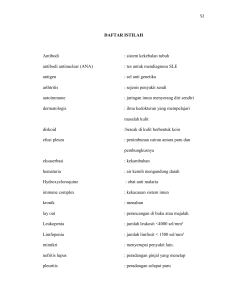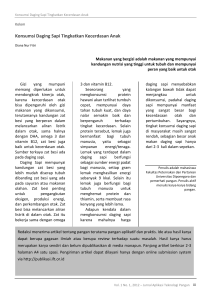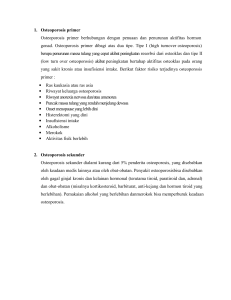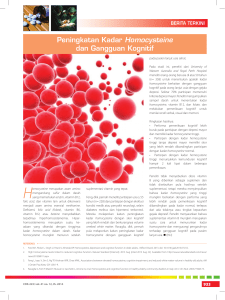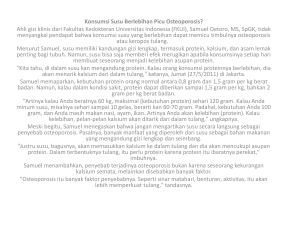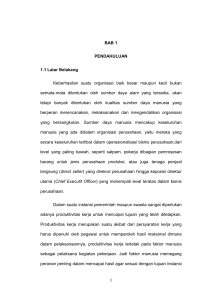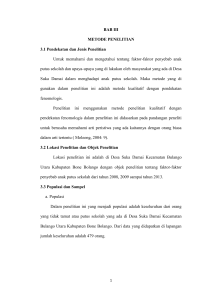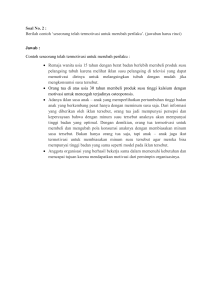LAPORAN AKHIR HASIL PENELITIAN UNGGULAN
advertisement
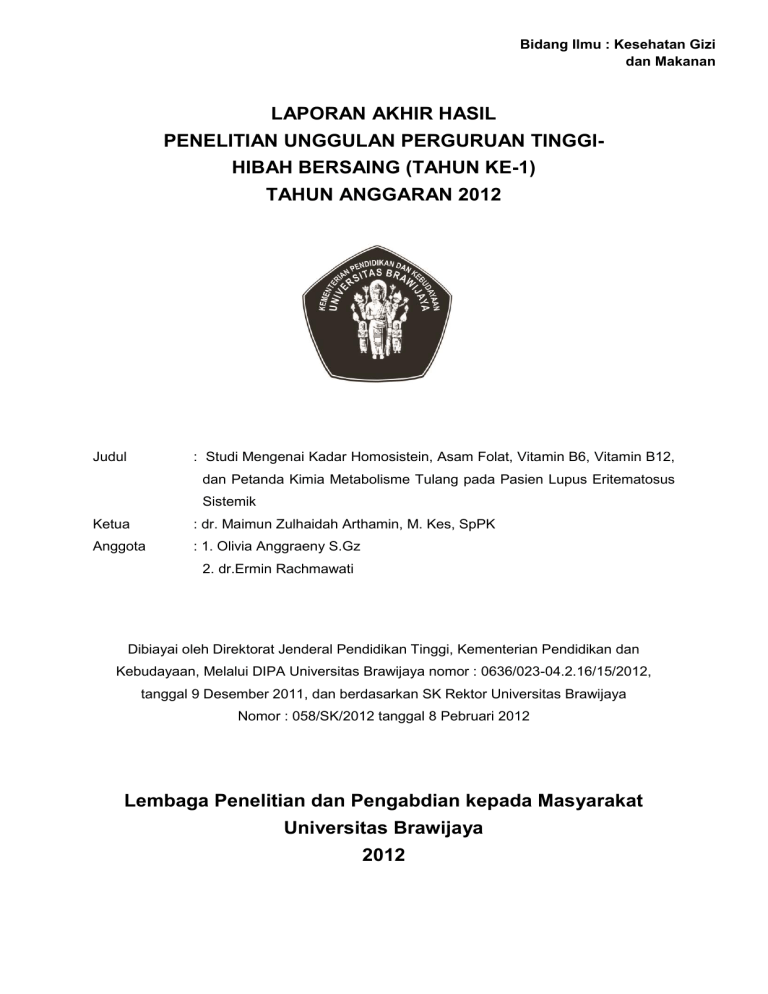
Bidang Ilmu : Kesehatan Gizi dan Makanan LAPORAN AKHIR HASIL PENELITIAN UNGGULAN PERGURUAN TINGGIHIBAH BERSAING (TAHUN KE-1) TAHUN ANGGARAN 2012 Judul : Studi Mengenai Kadar Homosistein, Asam Folat, Vitamin B6, Vitamin B12, dan Petanda Kimia Metabolisme Tulang pada Pasien Lupus Eritematosus Sistemik Ketua : dr. Maimun Zulhaidah Arthamin, M. Kes, SpPK Anggota : 1. Olivia Anggraeny S.Gz 2. dr.Ermin Rachmawati Dibiayai oleh Direktorat Jenderal Pendidikan Tinggi, Kementerian Pendidikan dan Kebudayaan, Melalui DIPA Universitas Brawijaya nomor : 0636/023-04.2.16/15/2012, tanggal 9 Desember 2011, dan berdasarkan SK Rektor Universitas Brawijaya Nomor : 058/SK/2012 tanggal 8 Pebruari 2012 Lembaga Penelitian dan Pengabdian kepada Masyarakat Universitas Brawijaya 2012 ABSTRAK Artamin, M. Z., Anggraeni, O., Rachmawati, E. 2012. Studi Mengenai Kadar Homosistein, Asam Folat, Vitamin B6, Vitamin B12, dan Petanda Kimia Metabolisme Tulang pada Pasien Lupus Eritematosus Sistemik Lupus eritematosus sistemik (LES) merupakan penyakit autoimun sistemik yang menyebabkan kerusakan pada beberapa organ. Penelitian yang dilakukan sebelumnya, melaporkan bahwa angka harapan hidup pasien LES di RSU Dr Saiful Anwar Malang masih sangat rendah dengan manifestasi klinis yang berat. Salah satu komplikasi LES dengan kejadian yang cukup tinggi adalah osteoporosis. Osteoporosis pada pasien LES terjadi lebih dini akibat dari proses inflamasi kronis, obat-obat glukocorticoid, serta faktor metabolik seperti defisiensi vitamin D dan homosistein. Homosistein merupakan faktor metabolik yang akhir-akhir ini banyak dipelajari terkait hubungannya dengan beberapa penyakit inflamasi. Tujuan penelitian ini adalah untuk mengetahui hubungan antara kadar homositein dan petanda kimia metabolisme tulang pada pasien LES. Penelitian ini merupakan penelitian analitik observasional dengan pendekatan cross sectional. Sampel penelitian adalah 39 pasien LES dengan kriteria inklusi tertentu, yang diambil sampel darah vena, untuk diperiksa kadar homosistein, asam folat, B6, B12, CTx, dan Osteocalcin serum. Pemeriksaan kadar variabel tersebut dilakukan dengan ELISA Kit spesifik. Hasil penelitian menunjukkan bahwa 71,8% kadar homositein pada sampel pasien LES mengalami peningkatan (>10 μmol/L). Peningkatan kadar homositein ini berhubungan dengan peningkatan kadar CTx (p=0,000, R=0,943) serta penurunan kadar Osteocalcin (p=0,000, R= 0,771). Selain itu, diperoleh data bahwa kadar asam folat, vitamin B6, dan vitamin B12 cenderung rendah. Hal ini disebabkan proses inflamasi dan proses peningkatan turn over ketiga kofaktor metabolisme homosistein tersebut sehingga terjadi kondisi hiperhomositeinemia, dimana kondisi ini akan mempengaruhi proses metabolisme tulang. Kata kunci : LES, homositein, Asam Folat, B6, B12, CTx, Osteocalcin, Osteoporosis ABSTRACT Artamin, M. Z., Anggraeni, O., Rachmawati, E. 2012. Study of Serum Homocysteine, Folic Acid, Vitamin B6, B12, and Biochemical Parameters of Bone Metabolism in Patients with Systemic Lupus Erythematosus Systemic lupus erythematosus (SLE) is an autoimmune disease that causes multiple organ damage. Previous research reported that life expectancy of patients with SLE in RSU Dr. Saiful Anwar Malang is still very low with severe clinical manifestations. One of SLE complication with high incidence was osteoporosis. Osteoporosis in SLE patients occur earlier due to a chronic inflammatory process, glukocorticoid drugs and metabolic factors such as vitamin D deficiency and homocysteine. Homocysteine is a metabolic factor lately been studied related with several inflammatory diseases. The purpose of this study was to determine the relationship between homositein levels and biochemical parameters of bone metabolism in patients with SLE. This study was observational analytic with cross sectional approach. The research sample was 39 SLE patients with specific inclusion criteria, a venous blood sample was taken to be examined levels of serum homocysteine, folic acid, B6, B12, CTx, and osteocalcin by specific ELISA kit. The results showed that 71.8% homositein levels in patient samples SLE was increased (> 10 μmol/L). Elevated levels of homositein associated with elevated levels of CTx (p = 0.000, R = 0.943) and decreased levels of osteocalcin (p = 0.000, R = 0.771). In addition, the data showed that the levels of folic acid, vitamin B6, and vitamin B12 tend to be low. This is due to chronic inflammatory process and the increase in cell turn over, so the three cofactors of homocysteine metabolism will decrease, and resulting hyperhomocyssteinemia conditions, which affect on bone metabolism. Key word : SLE, homocysteine, Folic Acid, B6, B12, CTx, Osteocalcin, Osteoporosis RINGKASAN Judul: Studi Mengenai Kadar Homosistein, Asam Folat, Vitamin B6, Vitamin B12, dan Petanda Kimia Metabolisme Tulang pada Pasien Lupus Eritematosus Sistemik Latar Belakang: Lupus eritematosus sistemik (LES) merupakan penyakit autoimun sistemik yang menyebabkan kerusakan pada beberapa organ dengan prevalensi yang cukup tinggi. Penelitian yang dilakukan sebelumnya, melaporkan bahwa angka harapan hidup pasien LES di RSU Dr Saiful Anwar Malang masih sangat rendah dengan manifestasi klinis yang berat. Tingginya angka morbiditas dan mortalitas pasien LES ini diakibatkan oleh perjalanan penyakit itu sendiri maupun akibat komplikasi. Salah satu komplikasi LES dengan kejadian yang cukup tinggi adalah osteoporosis. Osteoporosis pada pasien LES terjadi lebih dini akibat dari proses inflamasi kronis, obat-obat glukocorticoid, serta faktor metabolik seperti defisiensi vitamin D dan homosistein. Homosistein merupakan faktor metabolik yang akhirakhir ini banyak dipelajari terkait hubungannya dengan beberapa penyakit inflamasi. Tujuan penelitian ini adalah untuk mengetahui hubungan antara kadar homositein dan petanda kimia metabolisme tulang pada pasien LES. Metode Penelitian: Penelitian ini merupakan penelitian analitik observasional dengan pendekatan cross sectional. Sampel penelitian adalah pasien LES di poli reumatologi dan bangsal rawat inap RSU dr. Saiful Anwar Malang, dengan kriteria inklusi: wanita, usia 18-43 tahun, durasi penyakit 6 bulan – 2 tahun sejak pertama kali didiagnosis, tidak sedang hamil atau menyusui, batasan konsumsi steroid (Methylprednisolone < 30 mg/hari), tidak sedang menggunakan terapi hormon pengganti, suplemen asam folat, dan vitamin B, atau obatobatan seperti methotrexate, anti convulsan, nitrous oxide, theophylline. Jumlah sampel minimal yang diperoleh berdasarkan hasil penghitungan adalah 37 pasien. Selanjutnya pasien yang bersedia dan menandatangani informed consent diambil darah vena sebanyak 5 cc, untuk selanjutnya diukur kadar homositein, asam folat, B6, B12, CTx, dan osteocalcin. Pengukuran variabel tersebut dilakukan dengan metode ELISA dengan menggunakan ELISA Kit spesifik. Selain itu, pasien juga diminta untuk mengisi qestionaire intake makanan sehari-hari untuk mengetahui jumlah intake dari asam folat, B6, dan B12 pasien. Hasil Penelitian: Hasil penelitian menunjukkan bahwa 71,8% kadar homositein pada sampel pasien LES meningkat (>10 μmol/L). Peningkatan kadar homositein ini berhubungan dengan peningkatan kadar CTx (p=0,000, R=0,943) serta penurunan kadar Osteocalcin (p=0,000, R= 0,771). Selain itu, diperoleh data bahwa kadar asam folat pada 56,4% sampel mengalami penurunan (<5,4 nmol/L), kadar vitamin B6 pada 46,2% sampel menurun (< 6 nmol/L), begitu juga kadar vitamin B12 pada 51,3% dari sampel juga didapatkan mengalami penurunan (<150 pmol/L). Hal ini diduga disebabkan karena inflamasi kronis akibat proses autoimun serta peningkatan turn over sel pada pasien LES. Ketiga zat tersebut merupakan kofaktor metabolisme homosistein, sehingga apabila kadar nya rendah di dalam tubuh, maka akan terjadi kondisi hiperhomositeinemia, yang selanjutnya dapat mempengaruhi proses metabolisme tulang. Kesimpulan : Dari hasil penelitian ini dapat disimpulkan bahwa pada pasien LES cenderung mengalami peningkatan kadar homositen. Peningkatan kadar homosistein ini berpengaruh terhadap aktivitas metabolisme tulang, yaitu peningkatan proses resorbsi tulang yang ditandai dengan peningkatan kadar CTx dan penurunan kadar OC serum. Ketidakseimbangan metabolisme tulang ini dalam jangka waktu tertentu akan menyebabkan penurunan densitas masa tulang yang akan bermanifestasi sebagai osteoporosis. Penyebab peningkatan kadar homositein ini adalah penurunan kadar asam folat, B6, dan B12, yang diduga akibat proses inflamasi yang terjadi pada pasien LES. Dari data hasil penelitan ini, diharapkan dapat dijadikan data dasar untuk penelitian lebih lanjut mengenai homositein dan osteoporosis yang mungkin ke depan nya dapat dipertimbangkan mengenai pemberian terapi adjuvant asam folat, B6, dan B12 pada pasien LES untuk mencegah terjadinya proses osteoporosis dini. SUMMARY Title: Study of Serum Homocysteine, Folic Acid, Vitamin B6, B12, and Biochemical Parameters of Bone Metabolism in Patients with Systemic Lupus Erythematosus Background: Systemic lupus erythematosus (SLE) is an autoimmune disease that causes multiple organ damage. Previous research reported that life expectancy of SLE patients in RSU Dr. Saiful Anwar Malang is still very low with severe clinical manifestations. The high rates of morbidity and mortality in patients SLE is caused by the disease course itself and the complications. One of the SLE complication with high incidence was osteoporosis. Osteoporosis occur earlier in patient with SLE, it causes by chronic inflammatory process, glukocorticoid drugs, and metabolic factors such as vitamin D deficiency and homocysteine. Homocysteine is a metabolic factor lately been studied related to do with several inflammatory diseases. The purpose of this study was to determine the relationship between levels homositein and biochemical parameter of bone metabolism in patients with SLE. Methods: This study was observational analytic with cross sectional approach. The research sample was patient diagnosed as SLE at poly rheumatology and at ward RSU dr. Saiful Anwar Malang. Inclussion criteria: women, aged 18-43 years, disease duration 6 months - 2 years since first diagnosed, not pregnant or breastfeeding, limit consumption of steroids (Methylprednisolone <30 mg / day), not using hormone replacement therapy, folic acid or vitamin B supplements, and drugs such as methotrexate, anticonvulsant, nitrous oxide, theophylline. Minimum number of samples obtained by the results of the calculation are 37 patients. Furthermore, patients who are willing and informed consent, was taken 5 cc venous blood to measured homositein, folic acid, B6, B12, CTx, and osteocalcins serum level. Measurement of these variables is done by ELISA method using a specific ELISA kit. In addition, patients were also asked to fill qestionaire daily food intake to determine the amount of intake of folic acid, B6, and B12. Results: The results showed that 71.8% of patient samples have increase of homositein level (> 10 μmol / L). Elevation levels of homositein associated with elevated levels of CTx (p = 0.000, R = 0.943) and decreased levels of Osteocalcin (p = 0.000, R = 0.771). In addition, the data showed that the levels of folic acid in the was decreased (<5.4 nmol / L) at 56.4% sample, decreasing vitamin B6 level (<6 nmol / L) at 46.2% of sampel, as well as levels of vitamin B12 in 51.3% of samples were also found to decline (<150 pmol / L). This is thought to be caused by chronic inflammation caused by an autoimmune process and increase cell turnover in patients with SLE. These three substances are important cofactors of homocysteine metabolism, so if its low levels in the body, it will cause hiperhomositeinemia conditions, which in turn can affect bone metabolism. Conclusion: From these results it can be concluded that the patients tend to have elevated levels of LES homositen. Elevated levels of homocysteine associated with bone metabolic activities (increased levels of CTx and decreased levels of serum OC). This imbalance of bone metabolism in a certain period of time will cause a loss of bone density that will manifest as osteoporosis. The cause of elevated levels homositein are decreased levels of folic acid, B6, and B12, which may be due to the inflammatory process that occurs in patients with LES. From the research outcome data, is expected to be used as a baseline for further studies on homositein and osteoporosis that may be considered forward for the adjuvant therapy of folic acid, B6, and B12 in patients with LES to prevent the premature osteoporosis. DAFTAR PUSTAKA Baines M., Kredan, J. Usher, A. Davison, G. Higgins, W. Taylor, C. West, W.D. Fraser, L.R. Ranganath. 2007. The association of homocysteine and its determinants MTHFR genotype, folate, vitamin B12 and vitamin B6 with bone mineral density in postmenopausal British women. Bone, vol. 40, page 730–736 Bezerra M.C., J.F. Carvalho, A.S. Prokopowitsch, dan R.M.R. Pereira. 2005. RANK, RANKL and osteoprotegerin in arthritic bone loss. Brazilian Journal of Medical and Biological Research, vol. 38, page 161-170 Bultink I. E. M. 2012. Osteoporosis and Fractures in Systemic Lupus Erythematosus. Arthritis Care & Research, vol. 64, no. 1, page 2–8 Cagnacci A., Cannoletta M., Baldassari F, dan Volpe A. 2004. Low Vitamin B12 and Bone Loss: A Role for Folate Deficiency. J Clin Endocrinol Metab 89(9):4768–4774 Chigurupati S., Zelan Wei, Cherine Belal, Myriam Vandermey, George Kyriazis, Thiruma Arumugam, Sic L. Chan. 2009. The Homocysteine-Inducible Endoplasmic Reticulum Stress Protein Counteracts Calcium Store Depletion and Induction of C/EBP Homologous Protein in aA Neurotoxin Model of Parkinson Disease. JBC Papers in Press, vol. 5 Cooper C. 2003. Epidemiology of osteoporosis. In Primer on the Metabolic Bone Disease and Disorders of Mineral Metabolism 307–313 edn 5 (Ed Favus M). Washington DC: American Society for Bone and Mineral Research Elshorbagy A. K., Clara Gram Gjesdal, Eha Nurk, Grethe S. Tell, Per M. Ueland, Ottar Nyard, Aage Tverdal, Stein E. Vollset, A. David Smith, Helga Refsum. 2009. Cysteine, homocysteine and bone mineral density: A role for body composition. Bone, vol. 44, page 954–958 Gjesdal C. G., Stein Emil Vollset, Per Magne Ueland, Helga Refsum, Christian A. Drevon, Hakon K. Gjessing, Grethe S. Tell. 2006. Plasma Total Homocysteine Level and Bone Mineral Density. ARCH INTERN MED, vol 166, no. 9, page 88-95 Gordon C. Long-term complications of systemic lupus erythematosus. Rheumatology, vol. 4, page 1095–1100 Herrmann M., Johannes Schmidt , Natascha Umanskaya, Graziana Colaianni, Fuad Al Marrawi , Thomas Widmann, Alberta Zallone, Britt Wildemann, Wolfgang Herrmann. 2007. Stimulation of osteoclast activity by low B-vitamin concentrations. Bone, vol. 41, page 584–591 Herrmann M., Thomas Widmann, Graziana Colaianni, Silvia Colucci, Alberta Zallone, dan Wolfgang Herrmann. 2005. Increased Osteoclast Activity in the Presence of Increased Homocysteine Concentrations. Clinical Chemistry, vol. 5, no. 12, page 2348–2353 Keith R. 2007. Osteoporosis: Integrating Biomarkers and Other Diagnostic Correlates into the Management of Bone Fragility. Alternative Medicine Review, vol. 12, no. 2, page 113- 145 Kawiyana IKS. 2009. Osteoporosis : Patogenesis, Diagnosis Dan Penanganan Terkini. J Peny Dalam;10(2):157-168 Kim D.J., Park BL, Koh JM, Kim GS,Kim LH, Cheong HS, Shin HD,Hong JM,Kim TH, Shin HI,Park EK, and Kim SY. 2006. Methionine synthase reductase polymorphisms are associated with serum osteocalcin levels in postmenopausal women. Exp Mol Med. 38(5):519-24. Koh J.,Young-Sun Lee, Yang Soon Kim, Duk Jae Kim, Hong-Hee Kim, Joong-Yeol Park, KiUp Lee, dan Ghi Su Kim. 2006. Homocysteine Enhances Bone Resorption by Stimulation of Osteoclast Formation and Activity Through Increased Intracellular ROS Generation. Journal of Bone and Mineral Research, vol. 21, no. 7, page 1003-1011 Krishnamurthy S. dan Mahadevan S. 2011. Systemic Lupus Erythematosus: Recent Concepts in Genomics, Pathogenetic Mechanisms, and Therapies. International Scholarly Research Network (ISRN) Immunology, vol. 2011, page 1-7 Lacativa P. G. dan Farias M. L. 2010. Osteoporosis and Inflammation. Arq Bras Endocrinol Metab, vol. 54, no. 2, page 123-133 Lane N. E. 2006. Therapy Insight: osteoporosis and osteonecrosis in systemic lupus erythematosus. NATURE CLINICAL PRACTICE RHEUMATOLOGY, vol. 2, no. 10, page 562-569 Levasseur R. 2009. Bone tissue and hyperhomocysteinemia. Joint Bone Spine, vol. 76, page 234-240 Mattson M. P. dan Shea Thomas B. 2003. Folate and homocysteine metabolism in neural plasticity and neurodegenerative disorders. Trends in Neuroscience, vol. 26, issue 3, pages 137–146 Mok C C, Lau C S. 2003. Pathogenesis of systemic lupus erythematosus. J Clin Pathol, vol. 56, page 481–490 Okabe R, Nakatsuka K, Inaba M, et al. Clinical Evaluation of the Elecsys β-CrossLaps Serum Assay, a New Assay for Degradation Product of Type I Collagen CTelopeptides. Clinical Chemistry 2001;47(8):1410-1414. Park S. J., Kim K. J., Kim W. U., Oh I. H., Cho C. S. 2012. Involvement of endoplasmic reticulum stress in homocysteine-induced apoptosis of osteoblastic cells. Journal of Bone and Mineral Metabolism, vol. 6 Prado, D, Guerra-Shinohara,Galdieri, Terreri, Hilário MO. 2006. Increased concentration of plasma homocysteine in children with systemic lupus erythematosus. Clinical and Experimental Rheumatology; 24: 594-598. Raisz L. J. 2005. Pathogenesis of osteoporosis: concepts, conflicts, and prospects. The Journal of Clinical Investigation, vol. 115, page 3318–3325 Seibel M. J. 2005. Biochemical Markers of Bone Turnover Part I : Biochemistry and Variability. Clinical Biochemist Review, vol. 26, page 97-121 Selhub J. 2007. Homocysteine Metabolism. Annual Review of Nutrition, vol. 19, page 217– 246 Schroecksnadel K, Frick B, Winkler C, Leblhuber F, Wirleitner B dan Fuchs D. 2003. Review : Hyperhomocysteinemia and Immune Activation. Clin Chem Lab Med; 41(11):1438–1443 Singer F. R. dan Eyre D. R. 2008. Using biochemical markers of bone turnover in clinical practice. Clincal Joirnal of Medicine, vol. 75, no. 10, page 739-756 Wu J. T. 2007. Circulating Homocysteine Is An Inflammation Marker And A Risk Factor of Life-Threatening Inflammatory Diseases. Journal of Biomedical & Laboratory Sciences, vol. 19, no. 4, page 107-11
